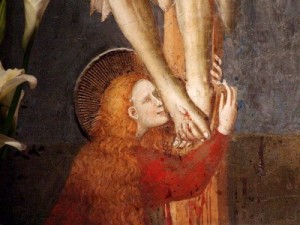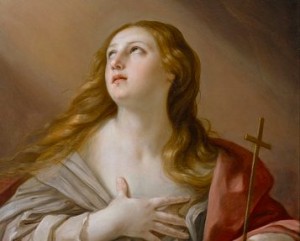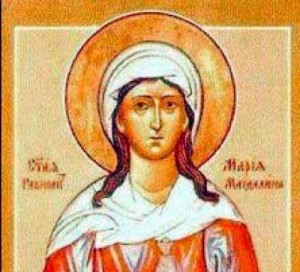The Feast Day of Mary Magdalene
This week saw the feast day of St. Mary Magdalene. As American Catholic explains:
Except for the mother of Jesus, few women are more honored in the Bible than Mary Magdalene. Yet she could well be the patron of the
slandered, since there has been a persistent legend in the Church that she is the unnamed sinful woman who anointed the feet of Jesus in Luke 7:36-50.
Most Scripture scholars today point out that there is no scriptural basis for confusing the two women. Mary Magdalene, that is, “of Magdala,” was the one from whom Christ cast out “seven demons” (Luke 8:2) — an indication, at the worst, of extreme demonic possession or, possibly, severe illness.
Father Wilfrid J. Harrington, O.P., writing in the New Catholic Commentary, says that “seven demons” “does not mean that Mary had lived an immoral life — a conclusion reached only by means of a mistaken identification with the anonymous woman of Luke 7:36.” Father Edward Mally, S.J., writing in the Jerome Biblical Commentary, agrees that she “is not … the same as the sinner of Luke 7:37, despite the later Western romantic tradition about her.”
Mary Magdalene was one of the many “who were assisting them [Jesus and the Twelve] out of their means.” She was one of those who stood by the cross of Jesus with his mother. And, of all the “official” witnesses that might have been chosen for the first awareness of the Resurrection, she was the one to whom that privilege was given. She is known as the “Apostle to the Apostles.”
Here are a few of her more notable appearances in the Gospels:
In Luke 8:2-3, she ministers to Christ: “And also some women who had been healed of evil spirits and infirmities: Mary, called Mag′dalene, from whom seven demons had gone out, and Jo-an′na, the wife of Chu′za, Herod’s steward, and Susanna, and many others, who provided for them[a] out of their means.”
In Mark 16:9, Jesus appeared to Mary Magdalene: “Now when he rose early on the first day of the week, he appeared first to Mary Mag′dalene, from whom he had cast out seven demons.”
Mary Magdalene is perhaps most remembered for her place in the Easter story. She is at the foot of the cross in each Gospel.
There were also women looking on from afar, among whom were Mary Mag′dalene, and Mary the mother of James the younger and of Joses, and Salo′me.
… among whom were Mary Mag′dalene, and Mary the mother of James and Joseph, and the mother of the sons of Zeb′edee.
So the soldiers did this. But standing by the cross of Jesus were his mother, and his mother’s sister, Mary the wife of Clopas, and Mary Mag′dalene.
And all his acquaintances and the women who had followed him
from Galilee stood at a distance and saw these things.
After the resurrection, Mary Magdalene discovered that Christ’s tomb was empty (John 20):
Now on the first day of the week Mary Mag′dalene came to the tomb early, while it was still dark, and saw that the stone had been taken away from the tomb. 2 So she ran, and went to Simon Peter and the other disciple, the one whom Jesus loved, and said to them, “They have taken the Lord out of the tomb, and we do not know where they have laid him.
In John 20:11-18, the risen Christ appears to her:
But Mary stood weeping outside the tomb, and as she wept she stooped to look into the tomb; and she saw two angels in white, sitting where the body of Jesus had lain, one at the head and one at the feet. They said to her, “Woman, why are you weeping?” She said to them, “Because they have taken away my Lord, and I do not know where they have laid him.” Saying this, she turned round and saw Jesus standing, but she did not know that it was Jesus. Jesus said to her, “Woman, why are you weeping? Whom do you seek?” Supposing him to be the gardener, she said to him, “Sir, if you have carried him away, tell me where you have laid him, and I will take him away.” Jesus said to her, “Mary.” She turned and said to him in Hebrew, “Rab-bo′ni!” (which means Teacher). Jesus said to her, “Do not hold me, for I have not yet ascended to the Father; but go to my brethren and say to them, I am ascending to my Father and your Father, to my God and your God.” Mary Mag′dalene went and said to the disciples, “I have seen the Lord”; and she told them that he had said these things to her.
No wonder so many Christians around the world celebrate this woman of faith.










